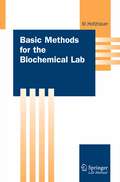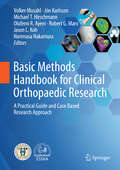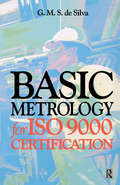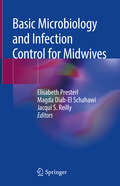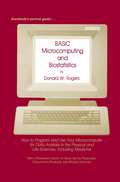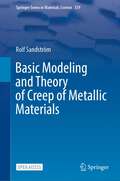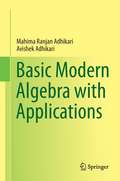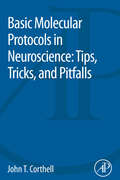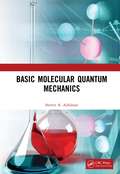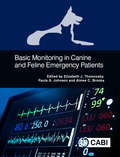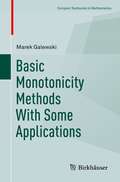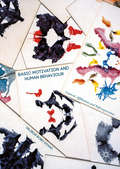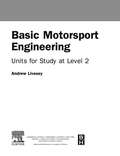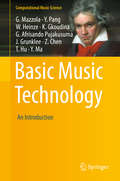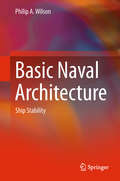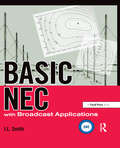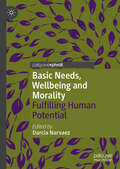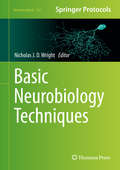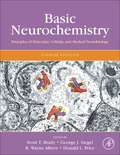- Table View
- List View
Basic Methods for the Biochemical Lab (Springer Lab Manuals)
by Martin HoltzhauerThis book presents proven lab procedures and practical hints for research in analytical and preparative biochemistry, and offers convenient key data in numerous tables. Coverage includes quantitative methods; electrophoresis; chromatographic protocols; immunochemical protocols; centrifugation; and radioactivity. In additional chapters, tables offer quick access to a broad array of useful information, including SI units conversion factors; detergent, protein and nucleotide data; and the basic principles of statistics and enzyme and receptor kinetics are reviewed. This first English-language edition of a successful German-language manual is a valuable resource for students and working professionals in biochemistry, biotechnology and biomedical laboratories.
Basic Methods Handbook for Clinical Orthopaedic Research: A Practical Guide and Case Based Research Approach
by Volker Musahl Jón Karlsson Michael T. Hirschmann Olufemi R. Ayeni Robert G. Marx Jason L. Koh Norimasa NakamuraThis book is designed to meet the needs of both novice and senior researchers in Orthopaedics by providing the essential, clinically relevant knowledge on research methodology that is sometimes overlooked during training. Readers will find a wealth of easy-to-understand information on all relevant aspects, from protocol design, the fundamentals of statistics, and the use of computer-based tools through to the performance of clinical studies with different levels of evidence, multicenter studies, systematic reviews, meta-analyses, and economic health care studies. A key feature is a series of typical case examples that will facilitate use of the volume as a handbook for most common research approaches and study types. Younger researchers will also appreciate the guidance on preparation of abstracts, poster and paper presentations, grant applications, and publications. The authors are internationally renowned orthopaedic surgeons with extensive research experience and the book is published in collaboration with ISAKOS.
Basic Methods of Policy Analysis and Planning -- Pearson eText
by Jennifer Clark David Sawicki Carl PattonUpdated in its 3rd edition, Basic Methods of Policy Analysis and Planning presents quickly applied methods for analyzing and resolving planning and policy issues at state, regional, and urban levels. Divided into two parts, Methods which presents quick methods in nine chapters and is organized around the steps in the policy analysis process, and Cases which presents seven policy cases, ranging in degree of complexity, the text provides readers with the resources they need for effective policy planning and analysis. Quantitative and qualitative methods are systematically combined to address policy dilemmas and urban planning problems. Readers and analysts utilizing this text gain comprehensive skills and background needed to impact public policy.
Basic Methods of Policy Analysis and Planning -- Pearson eText
by Jennifer Clark David Sawicki Carl PattonUpdated in its 3rd edition, Basic Methods of Policy Analysis and Planning presents quickly applied methods for analyzing and resolving planning and policy issues at state, regional, and urban levels. Divided into two parts, Methods which presents quick methods in nine chapters and is organized around the steps in the policy analysis process, and Cases which presents seven policy cases, ranging in degree of complexity, the text provides readers with the resources they need for effective policy planning and analysis. Quantitative and qualitative methods are systematically combined to address policy dilemmas and urban planning problems. Readers and analysts utilizing this text gain comprehensive skills and background needed to impact public policy.
Basic Metrology for ISO 9000 Certification
by G. M. de SilvaTraceable calibration of test and measurement equipment is a requirement of the ISO 9000 series of standards. Basic Metrology for ISO 9000 Certification provides essential information for the growing number of firms registered for ISO 9000. Dr. G.M.S. de Silva who has a lifetime of experience in metrology and quality management fields condenses that knowledge in this valuable and practical workbook. The book provides a basic understanding of the principles of measurement and calibration of measuring instruments falling into the following fields; Length,Angle, Mass, Pressure, Force, Temperature and AC/DC Electrical quantities. Basic concepts and definitions, ISO 9001 requirements and uncertainty determinations are also included.
Basic Metrology for ISO 9000 Certification
by G. M. de SilvaTraceable calibration of test and measurement equipment is a requirement of the ISO 9000 series of standards. Basic Metrology for ISO 9000 Certification provides essential information for the growing number of firms registered for ISO 9000. Dr. G.M.S. de Silva who has a lifetime of experience in metrology and quality management fields condenses that knowledge in this valuable and practical workbook. The book provides a basic understanding of the principles of measurement and calibration of measuring instruments falling into the following fields; Length,Angle, Mass, Pressure, Force, Temperature and AC/DC Electrical quantities. Basic concepts and definitions, ISO 9001 requirements and uncertainty determinations are also included.
Basic Microbiology and Infection Control for Midwives
by Elisabeth Presterl Magda Diab-El Schahawi Jacqui S. ReillyThis book provides an evidence-based, practical approach to the diagnosis and treatment of the most frequent fungal infections in a general hospital. It offers a comprehensive overview of the basic medical and scientific background of fungal infections and carefully explains and discusses epidemiology, pathogenesis, and clinical presentation. Readers will acquire a good and clear perception of invasive fungal infections, including diagnosis and treatment. This user-friendly resource not only serves as a valuable tool in clinical management, but also provides the basis for further research questions and studies in this particular field. It will be a useful companion for midwives as well as for doctors, medical and pharmacy students, nurses and other healthcare professionals.
BASIC Microcomputing and Biostatistics: How to Program and Use Your Microcomputer for Data Analysis in the Physical and Life Sciences, Including Medicine
by Donald W. RogersBASIC Microcomputing and Biostatistics is designed as the first practical "how to" guide to both computer programming in BASIC and the statis tical data processing techniques needed to analyze experimental, clinical, and other numerical data. It provides a small vocabulary of essential com puter statements and shows how they are used to solve problems in the bio logical, physical, and medical sciences. No mathematical background be yond algebra and an inkling of the principles of calculus is assumed. All more advanced mathematical techniques are developed from "scratch" before they are used. The computing language is BASIC, a high-level lan guage that is easy to learn and widely available using time-sharing com puter systems and personal microcomputers. The strategy of the book is to present computer programming at the outset and to use it throughout. BASIC is developed in a way reminiscent of graded readers used in human languages; the first programs are so sim ple that they can be read almost without an introduction to the language. Each program thereafter contains new vocabulary and one or more con cepts, explained in the text, not used in the previous ones. By gradual stages, the reader can progress from programs that do nothing more than count from one to ten to sophisticated programs for nonlinear curve fitting, matrix algebra, and multiple regression. There are 33 working programs and, except for the introductory ones, each performs a useful function in everyday data processing problems encountered by the experimentalist in many diverse fields.
Basic Modeling and Theory of Creep of Metallic Materials (Springer Series in Materials Science #339)
by Rolf SandströmThis open access book features an in-depth exploration of the intricate creep behavior exhibited by metallic materials, with a specific focus on elucidating the underlying mechanical properties governing their response at elevated temperatures, particularly in the context of polycrystalline alloys. Traditional approaches to characterizing mechanical properties have historically relied upon empirical models replete with numerous adjustable parameters, painstakingly tuned to match experimental data. While these methods offer practical simplicity, they often yield outcomes that defy meaningful extrapolation and application to novel systems, invariably necessitating the recalibration of parameters afresh.In stark contrast, this book compiles a compendium of models sourced from the scientific literature, meticulously crafted through ab initio methodologies rooted in fundamental physical principles. Notably, these models stand apart by their conspicuous absence of adjustable parameters. This pioneering effort is envisioned as a groundbreaking initiative, marking the first of its kind in the field. The resulting models, bereft of arbitrary tuning, offer a level of predictability hitherto unattained. Notably, they provide a secure foundation for ascertaining operational mechanisms, contributing significantly to enhancing our understanding of material behavior in high-temperature environments.This open access book is a valuable resource for researchers and seasoned students engaged in the study of creep phenomena in metallic materials. Readers will find a comprehensive exposition of these novel, parameter-free models, facilitating a deeper comprehension of the intricate mechanics governing material deformation at elevated temperatures.
Basic Modern Algebra with Applications
by Mahima Ranjan Adhikari Avishek AdhikariThe book is primarily intended as a textbook on modern algebra for undergraduate mathematics students. It is also useful for those who are interested in supplementary reading at a higher level. The text is designed in such a way that it encourages independent thinking and motivates students towards further study. The book covers all major topics in group, ring, vector space and module theory that are usually contained in a standard modern algebra text. In addition, it studies semigroup, group action, Hopf's group, topological groups and Lie groups with their actions, applications of ring theory to algebraic geometry, and defines Zariski topology, as well as applications of module theory to structure theory of rings and homological algebra. Algebraic aspects of classical number theory and algebraic number theory are also discussed with an eye to developing modern cryptography. Topics on applications to algebraic topology, category theory, algebraic geometry, algebraic number theory, cryptography and theoretical computer science interlink the subject with different areas. Each chapter discusses individual topics, starting from the basics, with the help of illustrative examples. This comprehensive text with a broad variety of concepts, applications, examples, exercises and historical notes represents a valuable and unique resource.
Basic Molecular Protocols in Neuroscience: Tips, Tricks, And Pitfalls
by John T. CorthellBasic Neuroscience Protocols: Tips, Tricks, and Pitfalls contains explanatory sections that describe the techniques and what each technique really tells the researcher on a scientific level. These explanations describe relevant controls, troubleshooting, and reaction components for some of the most widely used neuroscience protocols that remain difficult for many neuroscientists to implement successfully. Having this additional information will help researchers ensure that their experiments work the first time, and will also minimize the time spent working on a technique only to discover that the problem was them, and not their materials.Describes techniques in very specific detail with step-by-step instructions, giving researchers in-depth understandingOffers many details not present in other protocol booksDescribes relevant controls for each technique and what those controls meanChapters include references (key articles, books, protocols) for additional studyDescribes both the techniques and the habits necessary to get quality results, such as aseptic technique, aliquoting, and general laboratory rules
Basic Molecular Quantum Mechanics
by Steven A. AdelmanQuantum mechanics is a general theory of the motions, structures, properties, and behaviors of particles of atomic and subatomic dimensions. While quantum mechanics was created in the first third of the twentieth century by a handful of theoretical physicists working on a limited number of problems, it has further developed and is now applied by a great number of people working on a vast range of problems in wide areas of science and technology. Basic Molecular Quantum Mechanics introduces quantum mechanics by covering the fundamentals of quantum mechanics and some of its most important chemical applications: vibrational and rotational spectroscopy and electronic structure of atoms and molecules. Thoughtfully organized, the author builds up quantum mechanics systematically with each chapter preparing the student for the more advanced chapters and complex applications. Additional features include the following: This book presents rigorous and precise explanations of quantum mechanics and mathematical proofs. It contains qualitative discussions of key concepts with mathematics presented in the appendices. It provides problems and solutions at the end of each chapter to encourage understanding and application. This book is carefully written to emphasize its applications to chemistry and is a valuable resource for advanced undergraduates and beginning graduate students specializing in chemistry, in related fields such as chemical engineering and materials science, and in some areas of biology.
Basic Molecular Quantum Mechanics
by Steven A. AdelmanQuantum mechanics is a general theory of the motions, structures, properties, and behaviors of particles of atomic and subatomic dimensions. While quantum mechanics was created in the first third of the twentieth century by a handful of theoretical physicists working on a limited number of problems, it has further developed and is now applied by a great number of people working on a vast range of problems in wide areas of science and technology. Basic Molecular Quantum Mechanics introduces quantum mechanics by covering the fundamentals of quantum mechanics and some of its most important chemical applications: vibrational and rotational spectroscopy and electronic structure of atoms and molecules. Thoughtfully organized, the author builds up quantum mechanics systematically with each chapter preparing the student for the more advanced chapters and complex applications. Additional features include the following: This book presents rigorous and precise explanations of quantum mechanics and mathematical proofs. It contains qualitative discussions of key concepts with mathematics presented in the appendices. It provides problems and solutions at the end of each chapter to encourage understanding and application. This book is carefully written to emphasize its applications to chemistry and is a valuable resource for advanced undergraduates and beginning graduate students specializing in chemistry, in related fields such as chemical engineering and materials science, and in some areas of biology.
Basic Monitoring in Canine and Feline Emergency Patients
by Daniel S Foy Danielle Hundley Laura Ilie Kristen Marshall Adesola Odunayo Jessica L WardThis book discusses basic monitoring techniques that can be easily performed on emergency canine and feline patients in both first line emergency and primary care clinics. Techniques include blood pressure measurement, capnography, electrocardiography, pulse oximetry, and point of care monitoring ranging from the physical exam to bedside ultrasound and diagnostic tests such as PCV/TP, blood glucose and lactate. Each chapter begins with basic physiology as related to the monitoring technique, before reviewing how the piece of equipment used for monitoring works, pros and cons of the equipment, and limitations of the device. A simple, consistent layout for each chapter makes it easy to quickly locate information within the book. A final section in each chapter gives practical examples of how to use the monitoring technique in a clinical setting. The book also: - Emphasizes how physiology ties into what information each technique does (and does not) provide; - Includes pictures, tables, and diagrams to help explain concepts; - Delivers guidelines for rational interpretation of the results acquired. An important resource for both veterinary practitioners and students, this book provides a succinct approach to understanding the monitoring equipment used in emergency patients.
Basic Monotonicity Methods with Some Applications (Compact Textbooks in Mathematics)
by Marek GalewskiThis textbook introduces some basic tools from the theory of monotone operators together with some of their applications. Examples that work for ordinary differential equations are provided. The illustrating material is kept relatively simple, while at the same time offering inspiring applications to the reader. The material will appeal to graduate students in mathematics who want to learn some basics in the theory of monotone operators. Furthermore, it offers a smooth transition to studying more advanced topics pertaining to more refined applications by shifting to pseudomonotone operators, and next, to multivalued monotone operators.
Basic Motivation and Human Behaviour: Control, Affiliation and Self-expression
by Velibor Bobo KovacThis book explores how and why humans are motivated to act in the ways that they do. The chapters examine the origins of a given action rather than their superficial appearance, which can often be misleading. Kovac integrates the existing knowledge of the field of motivation into a greater theoretical framework by adopting both analytical and holistic perspectives. This theoretical framework suggests that all human behaviour evolves from the three fundamental underlying tendencies connected to the concepts of control, affiliation and self-expression that are further modified by the mechanism of balanced dual tension. These tendencies are conceptualised as systems of interrelated psychological needs that guide and govern a variety of human actions. As such, this book should be useful to upper-level students and researchers of cognitive and social psychology and all scholars interested in human motivation.
Basic Motorsport Engineering
by Andrew LiveseyMotorsport is not just about the spectacle of some of the world's most popular and famous sporting events - it also plays a crucial role in developing new techniques and technologies. Each unit in the IMI and EAL level 2 courses are covered in full, and the chapters can be easily matched to the BTEC First course structure. The book covers introductory topics in motorsport from vehicle science and maths through the basics of vehicle maintenance to pre and post race inspections.Written by an experienced teacher and author with decades of involvement with the industry, packed with detailed colour illustrations and learning tips, Basic Motorsport Engineering is the perfect textbook for you to make the first move into this most dynamic of industries.
Basic Motorsport Engineering
by Andrew LiveseyMotorsport is not just about the spectacle of some of the world's most popular and famous sporting events - it also plays a crucial role in developing new techniques and technologies. Each unit in the IMI and EAL level 2 courses are covered in full, and the chapters can be easily matched to the BTEC First course structure. The book covers introductory topics in motorsport from vehicle science and maths through the basics of vehicle maintenance to pre and post race inspections.Written by an experienced teacher and author with decades of involvement with the industry, packed with detailed colour illustrations and learning tips, Basic Motorsport Engineering is the perfect textbook for you to make the first move into this most dynamic of industries.
Basic Music Technology
by Guerino Mazzola Yan Pang William Heinze Kyriaki Gkoudina Gian Afrisando Pujakusuma Jacob Grunklee Zilu Chen Tianxue Hu Yiqing MaThis is an introduction to basic music technology, including acoustics for sound production and analysis, Fourier, frequency modulation, wavelets, and physical modeling and a classification of musical instruments and sound spaces for tuning and counterpoint. The acoustical theory is applied to its implementation in analogue and digital technology, including a detailed discussion of Fast Fourier Transform and MP3 compression. Beyond acoustics, the book discusses important symbolic sound event representation and software as typically realized by MIDI and denotator formalisms. The concluding chapters deal with globalization of music on the Internet, referring to iTunes, Spotify and similar environments. The book will be valuable for students of music, music informatics, and sound engineering.
Basic Naval Architecture: Ship Stability
by Philip A. WilsonThis textbook provides readers with an understanding of the basics of ship stability as it has been enacted in international law. The assessment of ship stability has evolved considerably since the first SOLAS convention after the sinking of the RMS Titanic, and this book enables readers to familiarise themselves with the most up-to-date modern day methodology, as well as looking ahead to the effects on ship design over the next fifty years. The author not only explains the methodology of probabilistic ship damage as required by the International Maritime Organisation (IMO), but also details the new requirements to assess certain sizes and classes of ships to the seven second-generation ship stability requirements. Many textbooks that are currently used by undergraduates focus on the geometric-centric deterministic approach to the assessment of ship stability, whereas this book also includes material on the classes of ships that are now required to have probabilistic ship damage assessment, as has only recently been agreed by the IMO. Basic Naval Architecture: Ship Stability contains up-to-date information, making it ideal for university students studying ocean or marine engineering, as well as being of interest to students on naval architecture and ship science courses. Highly illustrated and including chapter studies for ease of learning, the book is an ideal one-volume textbook for students.
Basic NEC with Broadcast Applications
by J.L. SmithBasic NEC with Broadcast Applications addresses computer modeling of MF directional broadcast antennas and illustrates the assets and liabilities of the Numerical Electromagnetic Code (NEC). The book's "how to" approach reveals the fundamentals of NEC operation, teaches broadcast applications and shows the reader how to use NEC-2 to: model non-radiating networks, verify calculations, detune unused towers, design top-loaded and skirted antennas, minimize coding by moving and duplicating structures, and much more! Complete with downloadable resources, the book is an invaluable toolkit with software necessary for the design and analysis of broadcast antenna arrays.
Basic NEC with Broadcast Applications
by J.L. SmithBasic NEC with Broadcast Applications addresses computer modeling of MF directional broadcast antennas and illustrates the assets and liabilities of the Numerical Electromagnetic Code (NEC). The book's "how to" approach reveals the fundamentals of NEC operation, teaches broadcast applications and shows the reader how to use NEC-2 to: model non-radiating networks, verify calculations, detune unused towers, design top-loaded and skirted antennas, minimize coding by moving and duplicating structures, and much more! Complete with downloadable resources, the book is an invaluable toolkit with software necessary for the design and analysis of broadcast antenna arrays.
Basic Needs, Wellbeing and Morality: Fulfilling Human Potential
by Darcia NarvaezBasic needs fulfilment is fundamental to becoming human and reaching one’s potential. Extending the BUCET list proposed by Susan Fiske - which includes belonging, understanding, control/competence, autonomy, self-enhancement, trust, purpose and life satisfaction - this book demonstrates that the fulfilment of basic needs predicts adult physical and mental health, as well as sociality and morality. The authors suggest that meeting basic needs in childhood vitally shapes one’s trajectory for self-actualization, and that initiatives aimed at human wellbeing should include a greater emphasis on early childhood experience. Through contemporaneous and retrospective research in childhood, the authors argue that basic need-fulfilment is key to the development of the self and the possibility of reaching one’s full potential. This book will be of interest to scholars of human wellbeing and societal flourishing, as well as to health workers and educators.
Basic Neurobiology Techniques (Neuromethods #152)
by Nicholas J. D. WrightThis volume explores the latest techniques and improved methods used to study important neurobiological and associated neuropathological conditions. Chapters cover topics such as the application of semiconductor quantum dots as photostable fluorophores used for labeling and tracking; GCaMP6 transcranial imaging to monitor neural activity; the patch-clamping technique allowing simultaneous monitoring of membrane currents and optical signals; and quantifying behavioral dysfunction caused by traumatic brain injury (TBI). In Neuromethods series style, chapters include the kind of detail and key advice from the specialists needed to get successful results in your laboratory.Cutting-edge and practical, Basic Neurobiology Techniques is a valuable resource for novel and expert researchers interested in expanding their knowledge of this developing field.
Basic Neurochemistry: Principles of Molecular, Cellular, and Medical Neurobiology
by Scott Brady Donald Price George Siegel R. Wayne AlbersBasic Neurochemistry, Eighth Edition, is the updated version of the outstanding and comprehensive classic text on neurochemistry. For more than forty years, this text has been the worldwide standard for information on the biochemistry of the nervous system, serving as a resource for postgraduate trainees and teachers in neurology, psychiatry, and basic neuroscience, as well as for medical, graduate, and postgraduate students and instructors in the neurosciences. The text has evolved, as intended, with the science. This new edition continues to cover the basics of neurochemistry as in the earlier editions, along with expanded and additional coverage of new research from intracellular trafficking, stem cells, adult neurogenesis, regeneration, and lipid messengers. It contains expanded coverage of all major neurodegenerative and psychiatric disorders, including the neurochemistry of addiction, pain, and hearing and balance; the neurobiology of learning and memory; sleep; myelin structure, development, and disease; autism; and neuroimmunology.Completely updated text with new authors and material, and many entirely new chaptersOver 400 fully revised figures in splendid color61 chapters covering the range of cellular, molecular and medical neuroscienceTranslational science boxes emphasizing the connections between basic and clinical neuroscienceCompanion website at http://elsevierdirect.com/companions/9780123749475
